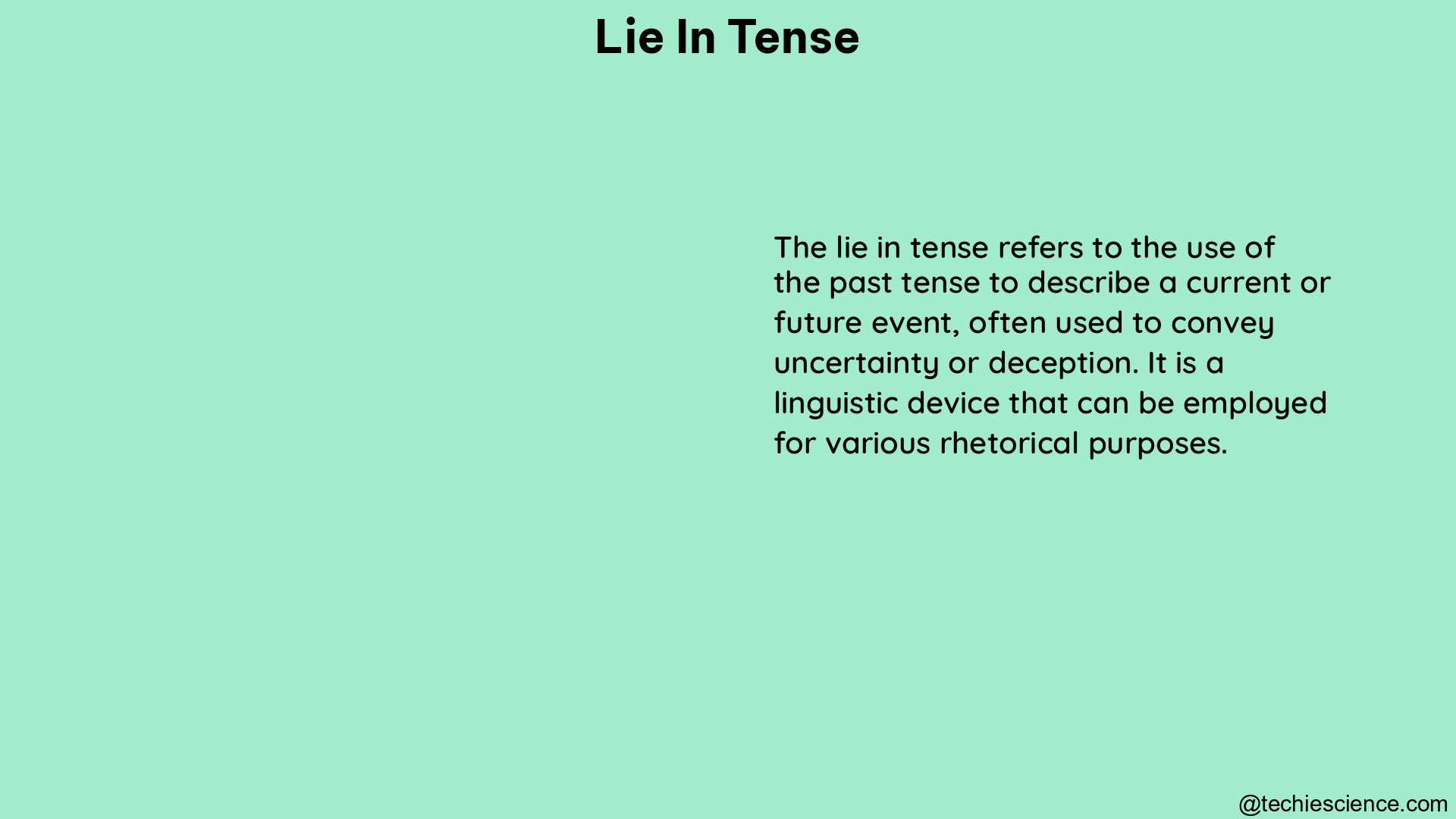The verb “lie” in English can be quite confusing due to its multiple meanings and grammatical specifications. This comprehensive guide will provide you with a deep understanding of how to use the lie tense correctly in various contexts, including the present tense, past tense, past participle, and progressive form. We’ll also explore the additional meaning of “lie” as an untruth and the differences between “lay” and “lie.” Get ready to become an expert on the lie tense!
Present Tense: Lying Down
In the present tense, the verb “lie” is used as an intransitive verb, meaning it does not require a direct object. When using “lie” in the present tense, it indicates that the subject is in a flat position on a surface.
Examples:
– I’m going to lie on that beach towel.
– If you’re tired, you can lie down on my bed and rest.
– Do you want to lie here and sleep while I go run errands?
It’s important to note that “lie” in the present tense is different from the verb “lay,” which is a transitive verb that requires a direct object. “Lay” means “to place something down flat,” whereas “lie” means “to be in a flat position on a surface.”
Past Tense: Laying Down

The past tense of the verb “lie” is “lay.” This can be a common source of confusion for English learners, as “lay” is also the past tense of the verb “lay.”
Examples:
– Yesterday, I lay on that beach towel until I got a sunburn.
– He was tired last night, so he lay on my bed and rested.
To help differentiate between the two, remember that “lay” is the past tense of the transitive verb “lay,” which means “to place something down flat,” while “lay” is the past tense of the intransitive verb “lie,” which means “to be in a flat position on a surface.”
Past Participle: Lain Down
The past participle of the verb “lie” is “lain.” This form is used to describe an action that has been completed in the past.
Examples:
– Joseph has lain there for hours.
– I have lain on the grass and observed insects before.
The past participle “lain” is formed by combining the past tense “lay” with the helping verb “have” or “has.” This structure is used to indicate that the action of lying down occurred before the current moment.
Progressive Form: Lying Down
The progressive form of the verb “lie” is “lying.” This form is used to describe an ongoing action in the present tense.
Examples:
– I am lying in bed right now.
– Derrick is lying about the grade he received on the exam.
The progressive form “lying” is created by combining the present tense of the verb “be” (am, is, are) with the present participle of the verb “lie.” This structure emphasizes that the action of lying down is happening at the current moment.
Additional Meaning: Telling a Lie
The verb “lie” can also be used to mean “to tell an intentionally false statement.” In this case, the past tense and past participle are “lied.”
Examples:
– We knew that what he said was a lie.
– My mom promised she wouldn’t ground me so long as I didn’t lie.
– I lied once before, and I didn’t like the way it made me feel.
– My brother has lied plenty of times before and has always gotten caught.
When using “lie” to mean “to tell an untruth,” it is important to remember that the past tense and past participle are different from the forms used for the meaning of “to be in a flat position.”
Key Differences Between “Lay” and “Lie”
To summarize the key differences between the verbs “lay” and “lie”:
- Lay is a transitive verb that requires a direct object, whereas lie is an intransitive verb that does not require an object.
- Lay means “to place something down flat,” while lie means “to be in a flat position on a surface.”
- The past tense of lie is lay, and the past participle is lain.
- Lay and lie have different meanings and grammatical specifications, making them easy to confuse.
Practice Exercises
To help solidify your understanding of the lie tense, try the following exercises:
- Fill in the blank with the correct form of “lie” or “lay”:
- Yesterday, I _____ on the beach for hours.
- The book _____ on the table.
- The baby has _____ in the crib for a long time.
-
I _____ the book on the shelf.
-
Identify the correct usage of “lie” or “lay” in the following sentences:
- The cat _____ on the couch.
- I need to _____ down for a nap.
- The worker _____ the bricks in a straight line.
-
The leaves _____ on the ground.
-
Rewrite the following sentences using the correct form of “lie” or “lay”:
- I lied about my grades.
- The dog laid on the floor.
- The painter has lain the canvas on the easel.
- I am laying on the beach towel.
By practicing these exercises, you’ll be well on your way to mastering the use of the lie tense in English.
References
- LanguageTool. (n.d.). Lay vs. Lie: How to Use Them Correctly. Retrieved from https://languagetool.org/insights/post/lay-vs-lie-word-choice/
- Cambridge Dictionary. (n.d.). Lay or lie? – English Grammar Today. Retrieved from https://dictionary.cambridge.org/us/grammar/british-grammar/lay-or-lie
- Britannica. (n.d.). Lay, Lie, Lied, Lain: When Do We Use Which? Retrieved from https://www.britannica.com/story/lay-lie-lied-lain-when-do-we-use-which
- Merriam-Webster. (n.d.). How to Use ‘Lay’ and ‘Lie’. Retrieved from https://www.merriam-webster.com/grammar/how-to-use-lay-and-lie
- San Jose State University. (n.d.). Lay vs. Lie. Retrieved from https://www.sjsu.edu/writingcenter/docs/handouts/Lay%20vs.%20Lie.pdf

Hi…. I am Goutam Datta. I have completed a double M. A. in English and B. Ed. I am a creative writer. Currently, I am a part of the LambdaGeeks.